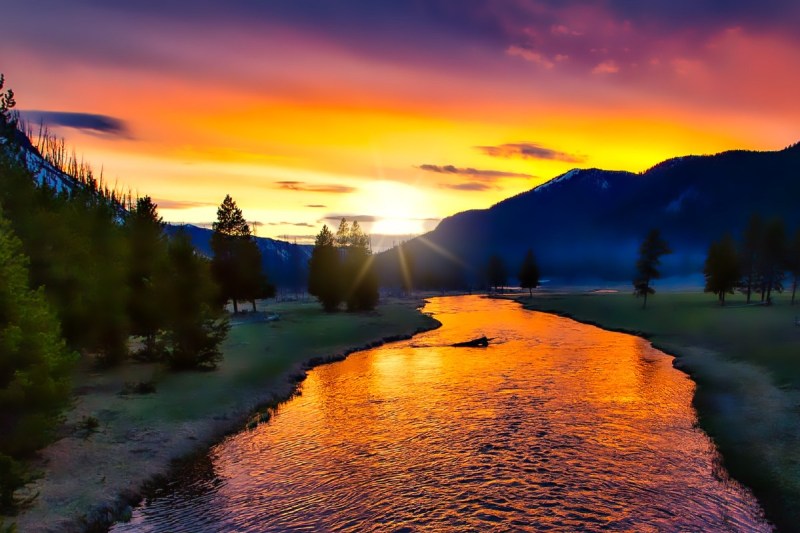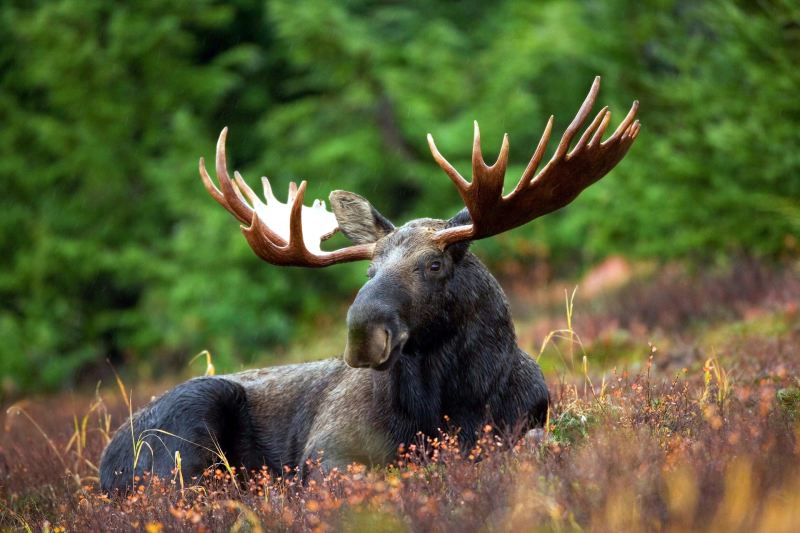
National Park officials are fed up with the irresponsible ways that travelers are interacting with wildlife. Just last month, a bison calf needed to be euthanized by Yellowstone Park officials after a man picked it up, causing it to be rejected by the herd. Unfortunately, this pattern of irresponsible behavior has become common in parks across the country.
Not many other people see the hard-hitting impacts more than Karen Blue, a wildlife photographer and ambassador for THOR Industries. Blue, her husband Lenny, and daughter Lilya share their Airstream Flying Cloud Trailer with their adorable dog Marley and colorful parrot, Mango. They work and school remotely while photographing North America’s most scenic destinations, embracing the freedom of the road and inspiring respect for wildlife everywhere they go.
It was a sincere pleasure to interview Karen Blue and hear her first-hand experiences with wildlife. Her passion for the safety of nature around us was so inspiring, and she has some great tips for encountering wildlife — and what things you should avoid at all costs.

Be responsible when encountering wildlife
The recent incidents involving human-animal contact shocked Blue to the core. She closely follows National Park news and spreads awareness about the situation whenever she can. From people taking selfies with bison to disrupting the ecosystem, she’s at her wit’s end, and so are the park officials. In order to ensure that we preserve our natural wildlife, it’s crucial that all visitors become aware of the risks before they head out on an adventure.
Keep your distance
Respecting the rules and guidelines set by park authorities is vital for the well-being of both wildlife and visitors. One of the most important rules here is to keep your distance. The general recommendation is to stay at least 25 yards (75 feet) away from most animals, and 100 yards (300 feet) away from predators like bears and wolves. This is not only for your safety but for theirs.
“Wildlife should not become habituated to human presence and dependent on human food,” Blue explained. “It’s crucial to maintain a safe distance and observe them in their natural environment.”
Follow the speed limit
Additionally, she highlighted that vehicle collisions are a leading cause of wildlife deaths, which is why the speed limits tend to be so slow. While it can be tempting to put the pedal to the metal, refrain from speeding and only stop in a designated pullout so animals do not get habituated to human presence.
Mind your food storage
One thing that park visitors might not realize is that feeding animals and not practicing proper food storage can make wildlife reliant on humans for food. “Conditioning wildlife to rely on an inconsistent food source can be a risk to the animal’s health, increase the likelihood of further human encounters, and ultimately lead to potential aggression and euthanization of the animal,” Blue said as she recounted a story from last year about one of Grizzly 399’s offspring. After the bear became habituated to people, hazing techniques failed and the bear had to be euthanized.
This heartbreaking story is one of many, but what about small animals like squirrels? While it seems harmless enough, Blue has seen firsthand how habituated marmots crawl into hikers’ laps and into their backpacks for food. Some of them are so aggressive that they will bite! “As an RVer staying in wild spaces, I have to be acutely aware of this and ensure that I leave no trace, including anything that has a scent left around my campsite,” she said.
Don’t ever approach animals
When interviewing Blue, I asked her what are some common mistakes people make when it comes to approaching animals. According to her, the mistake is approaching animals in the first place.
“The best way to observe wildlife is to place yourself at the right place at the right time and be patient,” she said, “Leave plenty of room and never corner an animal.” Young animals usually have a mother nearby, so if you see one, Blue recommends that you immediately leave the area.
When photographing animals in the wild, she usually picks a spot and lets the animals move about freely in her presence. She always pays attention to how the animal feels about her presence. If the animal isn’t reacting to her, she knows that it either is comfortable with her, or hasn’t seen her yet. Startling an animal is dangerous, so she never makes sudden moves. If the animal pulls their ears back or their hair stands up on its back, they are very likely to charge. That’s when safety equipment comes in handy (more on that later).
What Karen Blue does if an animal approaches
When hiking out in the wild, there’s always a risk that an animal will approach you. Blue has had three unexpected encounters, two with bears and one with a moose.
One bear encounter was on a trail in Glacier National Park. As she and her family were hiking, they came around a bend to find a young man face-to-face with a bear. “We stayed calm and firmly vocalized, ‘Hey bear, go away, bear!'” she shared. “Of course, we don’t expect the bear to understand, but this helped to notify any other hikers on the trail that there was a bear nearby.” Slowly, with bear spray ready, they backed out of the bear’s way until it went back into the woods.
The second bear encounter was at Denali National Park. They were camping with their friends, enjoying some coffee, when Lilya spotted a huge grizzly headed in their direction. Since she was in the next campsite over, she used their walkie-talkies to notify Karen, her husband Lenny, and their friends of the situation. Blue recounted the tale with vivid detail. “We all piled into our friends’ RV and watched the bear as he made his way toward the campground amphitheater where there was a large berry bush,” she said. After the bear was full, he went off on his way. They ended up seeing the bear again the next day, and soon they filed two incident reports with the park service so they could begin hazing techniques.
The third encounter was with a moose. She was drifting in a lake among a large patch of lily pads, when suddenly a moose started crossing the lake right in front of her. Staying calm, she didn’t make any sudden moves as the moose passed.

Tips and tools for safe wildlife photography
You don’t want to get into an unsafe situation when there are wild animals around, but wanting to take a few photos is understandable. Here’s how a professional wildlife photographer keeps herself safe when getting that perfect shot.
Carry essential safety equipment
When venturing into the wild, being prepared with the right safety equipment is of utmost importance. Blue doesn’t carry noise makers or bear bangers, but she does talk loudly and vocalizes cadences with her daughter so animals know that she is nearby.
- Bear spray. She strongly advocates carrying bear spray and replacing it regularly. “It provides an extra layer of protection in case of unexpected encounters with wildlife,” she explained.
- Binoculars. Binoculars are great tools to see if animals are nearby, so she always keeps those handy.
- A way to pick up trash. Additionally, she practices Leave No Trace principles, going the extra mile by picking up any trash she comes across, even if it isn’t hers. That way, animals don’t choke on it.
Blue’s long-range camera lens recommendations for animal photography
Because of the distancing rules, Blue uses a long-range lens to photograph wildlife. She shoots with a Canon R5 and a Canon 5D Mark IV, and her favorite lens, which she used prior to the addition of her mirrorless body, is the Canon 300f2.8 prime because of its low depth of field capabilities. Sometimes, it doesn’t have the reach she needs, so she pairs it with a 2x extender, which allows her to photograph at a 600mm range at a loss of 2 stops of aperture and create amazing bokeh effects.
There are other great options to choose from, too. For those looking for affordability, she suggests the Sigma 150-600mm f5-6.3 lens, which offers incredible range under $1,000. On the higher end, the Canon RF 100-500mm f4.5-7.1 lens provides versatility, while the Canon 400mm f2.8 lens stands out for its exceptional quality and performance.
How to balance photography with minimizing the impact on wildlife
While capturing captivating photographs is a goal for many wildlife enthusiasts, it is essential to prioritize the well-being of the animals and their habitats. Reflecting on her past mistakes, Blue states, “I’ve come to learn that I am a visitor in these natural spaces, and just like if I were visiting a friend’s home, I would show gratitude and care for their space and resources. If I didn’t do this, I would destroy our relationship and would never be invited back. I remind myself of this when I’m behind the lens, and hopefully, I can respectfully share the lessons I have learned along the way.”
Safely encountering animals in the wild is not only a responsibility, but a privilege. By adopting Karen Blue’s mindset of gratitude and care, we can minimize our impact on wildlife and their habitats so that future generations can also enjoy the beauty of North America’s magnificent creatures.
Editors' Recommendations
- Yellowstone National Park tip: Don’t dangle your baby near an elk like the guy in this video
- You may want an electric mountain bike, but you probably shouldn’t buy one – here’s why



